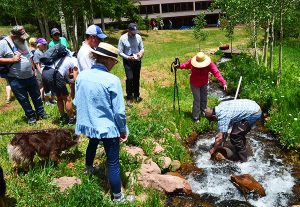by Carol Dunn
If you stir around in the leaf litter next to your house and trees, you may find that the Western Box Elder Beetles, known locally as adobe bugs, are beginning to hatch and search out food sources. You can find all life stages of the beetles at any given time, but the small hatchlings, called nymphs (about 1/16” in length), are most plentiful right now.
Box elder beetles are not much of a problem as an agricultural pest, but they certainly are a nuisance. In cold weather, they manage to find their way into homes and garages. Indoors, they can simply be eliminated by vacuuming. Outdoors, their excrement stains windows, doors, porches, house siding, windowsills, and other places where they congregate. Unfortunately, they are not a favorite prey of birds because they have an unsavory taste.
If you want to get the jump on a box elder beetle infestation, you can do it without using harsh chemicals. Many locals recommend spraying with a solution of water and dishwashing liquid containing anionic surfactants. This is a typical dishwashing liquid, nothing fancy. Mix about 1 teaspoon dishwashing liquid to a quart of water. You can use a handheld sprayer or a backpack, depending on the size of your infestation.
Wherever you have accumulations of leaf litter, against your house foundation or piled at the base of trees, dig it loose and spread it around. If you have an infestation, you’ll see the tiny scarlet nymphs. Spray as many of them as you can. The spray needs to contact the insects to kill them, and it works on all stages of the beetle’s development. Another place to find large numbers of adobe bugs is on the sides of trees or rocks where the sun is shining. They gravitate toward heat. You can find large masses of them bunched together in sunny locations. If the mass is disturbed, the beetles will fall or jump to the ground or fly away if they have developed their wings.
Adobe bugs prefer to feed on Acer (maple) species, with box elder trees being their favorite locally. But they can be found on just about any plant in your landscape, exploring, tasting or feeding. If you catch your infestation early, you can keep it under control and won’t be troubled by having the beetles move into your home in the fall.

Breaking news: Results of Walsenburg Mayor race and recall election
Gary M. Vezzani was elected Walsenburg’s mayor in Tuesday’s special mayoral election/recall vote. Preliminary results announced Tuesday night show that both Nick Vigil in Ward



